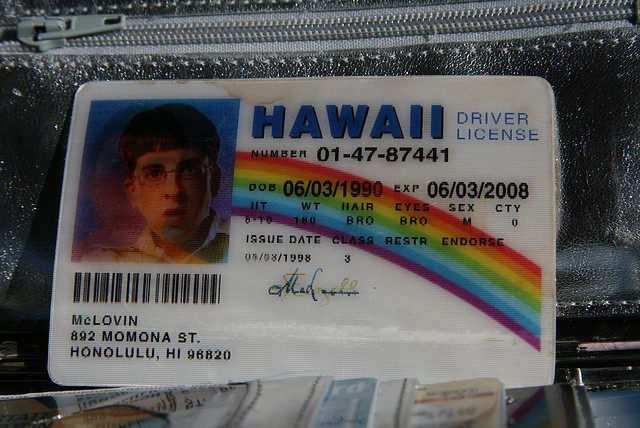The Golden Age of Fake IDs Could Be Over

McLovin will be out of luck (Photo: youngthousands/Flickr)
The past century has been a golden age of identification documents.
As international travel and auto ownership boomed, so did the use of licenses and passports. And as the need for government-issued IDs grew, so did the demand for fake ones. But have the glory days passed as biometrics replace paper forms? Will new facial recognition technology make harder than ever to get a fake ID—or to use one?
For now, it’s still possible for an underage drinker to borrow an older sibling’s license and sneak into a bar. But the technology already exists to foil that plan; the only question is how far it will spread and who will be allowed to use it.
Early IDs didn’t include photographs. A British passport issued a century ago, for instance, would have described a person’s features, with more details than today’s standard height, weight, hair and eye color. But today, the photograph used on a driver’s license or passport is one of its key features, and as facial recognition technology improves, those photos are being used to prove that you are who you say you are.
Over the past few years, state DMVs across the country have been implementing programs to stop people from getting false identifications to begin with. When a person seeking a new license visits the DMV, their image is checked against a database of photos. If the person is trying to obtain a false ID—because they’re trying to shed their old, shitty driving record, because they’re trying to steal another person’s identity, or any one of myriad reasons one would try to scam a new card—their face won’t match the photos associated with their assumed name. Or the search will find photos of that person under their true name.
This technology’s essentially the same as the algorithms that let Facebook automatically identify people in posted photos. But it’s been very effective in cracking down on fraud. A couple years ago, the New York DMV announced that it had arrested more than 2,500 people as a result of identity fraud investigations that grew from this technology, in the few years it’d been in use. New Jersey identified almost 1,000 potential criminal cases. In Arizona, the number of potential ID fraud cases identified increased by 860 percent, the Arizona Republic reported.
And just this year, the federal government’s Customs and Border Protection started a pilot program that uses facial recognition technology to check that the person using a passport is the same person in the passport’s photo. The digital chip inside all newer passports contains a digital copy of your passport photo; at passport control, the person trying to use the passport has their photo taken, and if the two don’t match, the customs agent can investigate further.
Coming back from Mexico at the end of April, I had to use a system matching this description: At a kiosk at New York’s JFK airport, I scanned my passport, positioned my head in front of a camera and took a selfie. The machine spit out a little piece of paper, which I handed over to an agent—and, no questions asked, I was back in the country. (There was a longer line, though, of people who the machine hadn’t automatically approved.)
It’s not hard to imagine this technology being used regularly in bars (and putting bouncers out of work). But privacy advocates are seeking to limit the spread of facial recognition technology: requiring people to take pictures of themselves to enter a bar or any other private spaces would create a vast database of photos that could be used to track an individual wherever she went. And it’s just as easy to imagine that more Americans would take issue with that reality than with teenagers drinking a few beers before they’re really supposed to. (Plus, spies aren’t too keen on it, either.) For now, at least, it’s still easy for college students to get and use fake IDs. As long as they come from China.







Follow us on Twitter to get the latest on the world's hidden wonders.
Like us on Facebook to get the latest on the world's hidden wonders.
Follow us on Twitter Like us on Facebook